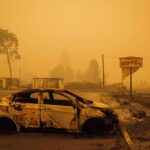According to catastrophe modeling firm AIR Worldwide, Windstorm Andrea passed through the U.K. earlier this week, fast on the heels of Windstorm Ulli, which brought widespread travel and power disruptions to Scotland. The storm is the first in 2012. It formed southwest of Iceland on January 3rd.
On Wednesday night and Thursday morning Andrea passed to the north of the U.K., bringing strong winds, particularly to central England, and causing power outages and travel disruption. “The system intensified as it traveled east,” explained said Dr. Gerhard Zuba, senior principal scientist at AIR Worldwide.
By the weekend the storm was “centered over Denmark with a central pressure of 964mb—down from 971mb the day before,” he continued. In Germany its high winds have caused a number of auto accidents, as well as power outages, and flooding. Both Germany and Austria have been the hardest hit by this early January storm, with flooding impacting the country’s northern region and high winds extending as far south as Bavaria.
According to AIR, “Andrea’s path brought it north of Scotland and through the North Sea, then south to Denmark and Poland. Its strongest winds—to the south of the storm’s track—were ultimately weaker than expected. Thus, Andrea caused less disruption in the United Kingdom than had Ulli earlier in the week. Due to Andrea’s southeastward path, however, it went into Germany, which Ulli had bypassed; thus, Andrea had higher wind speeds in Germany than its predecessor.”
Dr. Zuba explained: “Typically, strong extra tropical cyclones approaching Germany from the North Sea, as Andrea did, push water against the German coast, causing flooding. Indeed, there was flooding in the low laying areas of Germany today (i.e., Hamburg). Also, because they obtain their energy from temperature gradients rather than from warm ocean water, which is the fuel for hurricanes, these storms can extend far inland. This explains why Andrea brought very strong wind gusts as far south as Bavaria today.”
Over the past few months, northern Europe has seen a number of significant storms pass through, beginning with Xaver and Yoda which impacted the region in late November. These were followed by Friedhelm in early December, both Joachim and Patrick (Dagmar) in late December, and Ulli (which formed on December 31st) in early January. This clustering effect of windstorms in Europe—storms following closely on the heels of one another—is a well-studied phenomenon and is explicitly accounted for in the AIR Extratropical Cyclone Model for Europe.
AIR pointed out that the majority of “residential building stock in the areas affected by Andrea is predominantly of masonry construction. For commercial exposures, however, and particularly for commercial exposures in Germany, the building stock uses a wider variety of construction materials. Smaller office buildings, hotels, and other smaller commercial structures are usually masonry but larger buildings are generally made of reinforced concrete or steel.”
According to AIR,” little structural damage to these construction types is expected for wind speeds of the order widely experienced from Andrea, although damage to cladding, signage, and some isolated roof covering damage could occur. The flooding that occurred in Germany, however, may cause some damage; when residential buildings are subjected to floodwaters, most of the damage is limited to the basements, although the first floors of homes can also be submerged during severe flood events. In Germany, however, about 80 percent of all residential structures have basements, which alleviate the flood risk to floors above ground.”
Source: AIR Worldwide
Topics Trends Catastrophe Natural Disasters Windstorm Flood Europe Germany
Was this article valuable?
Here are more articles you may enjoy.


 Liberty Mutual Posts $1.5B Net Income for Q1, Reversing Loss
Liberty Mutual Posts $1.5B Net Income for Q1, Reversing Loss  The Top 15 U.S. Metros with High Exposure to Wildfire Risk
The Top 15 U.S. Metros with High Exposure to Wildfire Risk  Michigan Supreme Court Rules Against Couple in Drone Surveillance Case
Michigan Supreme Court Rules Against Couple in Drone Surveillance Case  Cracks in O’Hare Columns Aren’t Insured Property Damage, Just Bad Product – Court
Cracks in O’Hare Columns Aren’t Insured Property Damage, Just Bad Product – Court 

